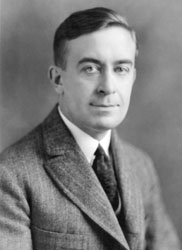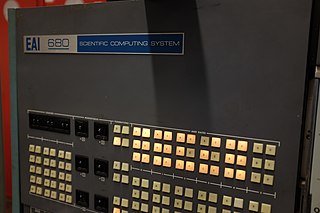Control Data Corporation (CDC) was a mainframe and supercomputer company that in the 1960s was one of the nine major U.S. computer companies, which group included IBM, the Burroughs Corporation, and the Digital Equipment Corporation (DEC), the NCR Corporation (NCR), General Electric, and Honeywell, RCA and UNIVAC. For most of the 1960s, the strength of CDC was the work of the electrical engineer Seymour Cray who developed a series of fast computers, then considered the fastest computing machines in the world; in the 1970s, Cray left the Control Data Corporation and founded Cray Research (CRI) to design and make supercomputers. In 1988, after much financial loss, the Control Data Corporation began withdrawing from making computers and sold the affiliated companies of CDC; in 1992, Cray established Control Data Systems, Inc. The remaining affiliate companies of CDC currently do business as the software company Ceridian.

Engineering Research Associates, commonly known as ERA, was a pioneering computer firm from the 1950s. ERA became famous for their numerical computers, but as the market expanded they became better known for their drum memory systems. They were eventually purchased by Remington Rand and merged into their UNIVAC department. Many of the company founders later left to form Control Data Corporation.
National Semiconductor was an American semiconductor manufacturer which specialized in analog devices and subsystems, formerly with headquarters in Santa Clara, California. The company produced power management integrated circuits, display drivers, audio and operational amplifiers, communication interface products and data conversion solutions. National's key markets included wireless handsets, displays and a variety of broad electronics markets, including medical, automotive, industrial and test and measurement applications.

Sperry Corporation was a major American equipment and electronics company whose existence spanned more than seven decades of the 20th century. Sperry ceased to exist in 1986 following a prolonged hostile takeover bid engineered by Burroughs Corporation, which merged the combined operation under the new name Unisys. Some of Sperry's former divisions became part of Honeywell, Lockheed Martin, Raytheon Technologies, and Northrop Grumman.

UNIVAC was a line of electronic digital stored-program computers starting with the products of the Eckert–Mauchly Computer Corporation. Later the name was applied to a division of the Remington Rand company and successor organizations.

Remington Rand, Inc. was an early American business machine manufacturer, originally a typewriter manufacturer and in a later incarnation the manufacturer of the UNIVAC line of mainframe computers. Formed in 1927 following a merger, Remington Rand was a diversified conglomerate making other office equipment, electric shavers, etc. The Remington Rand Building at 315 Park Avenue South in New York City is a 20-floor skyscraper completed in 1911. After 1955, Remington Rand had a long series of mergers and acquisitions that eventually resulted in the formation of Unisys.

Elmer Ambrose Sperry Sr. was an American inventor and entrepreneur, most famous for construction, two years after Hermann Anschütz-Kaempfe, of the gyrocompass and as founder of the Sperry Gyroscope Company. He was known as the "father of modern navigation technology".
Harry Franklin Vickers was an American inventor and industrialist. He grew up in Montana and southern California. He was called the "Father of Industrial Hydraulics" by the American Society of Mechanical Engineers, who gave him the Society's highest award, the ASME Medal, in 1956.
The BUNCH was the nickname for the group of mainframe computer competitors of IBM in the 1970s. The name is derived from the names of the five companies: Burroughs, UNIVAC, NCR, Control Data Corporation (CDC), and Honeywell. These companies were grouped together because the market share of IBM was much higher than all of its competitors put together.
The Eckert–Mauchly Computer Corporation (EMCC) was a computer company founded by J. Presper Eckert and John Mauchly. It was incorporated on December 22, 1947. After building the ENIAC at the University of Pennsylvania, Eckert and Mauchly formed EMCC to build new computer designs for commercial and military applications. The company was initially called the Electronic Control Company, changing its name to Eckert–Mauchly Computer Corporation when it was incorporated. In 1950, the company was sold to Remington Rand, which later merged with Sperry Corporation to become Sperry Rand, and survives today as Unisys.
Philco is an American electronics manufacturer headquartered in Philadelphia. Philco was a pioneer in battery, radio, and television production. In 1961, the company was purchased by Ford and, from 1966, renamed "Philco-Ford". Ford sold the company to GTE in 1974, and it was purchased by Philips in 1981. In North America, the Philco brand is owned by Philips. In other markets, the Philco International brand is owned by Electrolux.
Honeywell, Inc. v. Sperry Rand Corp., et al., 180 U.S.P.Q. 673, was a landmark U.S. federal court case that in October 1973 invalidated the 1964 patent for the ENIAC, the world's first general-purpose electronic digital computer. The decision held, in part, the following: 1. that the ENIAC inventors had derived the subject matter of the electronic digital computer from the Atanasoff–Berry computer (ABC), prototyped in 1939 by John Atanasoff and Clifford Berry, 2. that Atanasoff should have legal recognition as the inventor of the first electronic digital computer and 3. that the invention of the electronic digital computer ought to be placed in the public domain.

James Henry Rand Jr. was an American industrialist who revolutionized the business record industry. He founded American Kardex, an office equipment and office supplies firm which later merged with his father's company, the Rand Ledger Corporation. Rand later bought out and merged with several other companies, notably the Remington Typewriter Company, to form Remington Rand. In 1955, Rand merged his corporation with the Sperry Corporation to form Sperry-Rand, one of the earliest and largest computer manufacturing companies in the United States.

Alfred Victor Verville was an American aviation pioneer and aircraft designer who contributed to civilian and military aviation. During his forty-seven years in the aviation industry, he was responsible for the design and development of nearly twenty commercial and military airplanes. Verville is known for designing flying boats, military racing airplanes, and a series of commercial cabin airplanes. His planes were awarded with the Pulitzer Speed Classic Trophy in 1920 and 1924.

The RAND Corporation is an American nonprofit global policy think tank, research institute, and public sector consulting firm. RAND Corporation engages in research and development (R&D) across multiple fields and industries. Since the 1950s, RAND research has helped inform United States policy decisions on a wide variety of issues, including the space race, the Vietnam War, the U.S.-Soviet nuclear arms confrontation, the creation of the Great Society social welfare programs, and national health care.
Kardex has been the name or part of the name of companies tracing back to Rand Ledger founded in 1898, which were closely associated with the development of the index card as a common business data storage device, and which were also associated with the entities that eventually became part of Unisys.

Electronic Associates, Inc. (EAI) was founded in 1945 by Lloyd F. Christianson and Arthur L. Adamson and began manufacturing analog computers in 1952. Their systems were used by NASA to develop space probes and simulate physical systems. As digital technology matured, they began production of both hybrid digital/analog systems, such as the EAI680 with 156 amplifiers, diode function generators and servo-controlled potentiometers to control input parameters, and digital computers such as the EAI 640.
Hannibal Choate Ford (1877–1955) was an American inventor and electrical engineer best known for his work during the first half of the 20th century.
Project Cyclone was a 20-year initiative of the US Office of Naval Research that lasted from 1946 to the mid-1960s. It was one of a series of projects whose purpose was to develop a computer laboratory with a company in the private sector that would do research and development on missile systems, as well as on classified problems in navigation, ballistics, engine control, electrical circuit analysis, and other fields. A secondary motivation was to strengthen the US's connections with civilian scientists and technology companies that had developed during WWII.

The Reeves Electronic Analog Computer was a family of early analog computers produced in the United States by Reeves Instrument Corporation from the 1940s through the 1960s.










